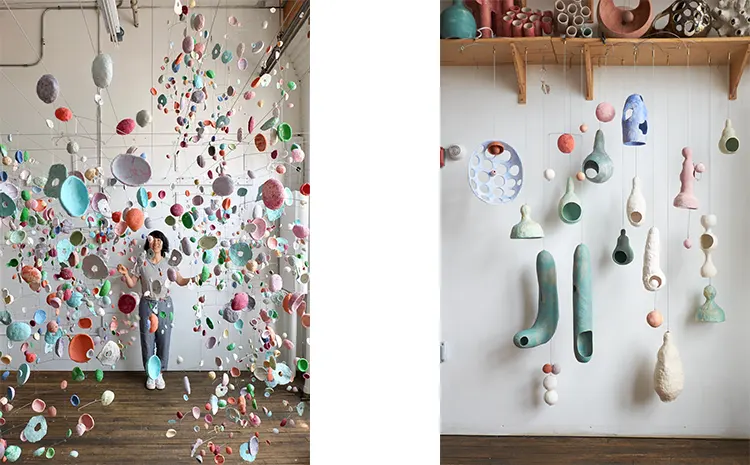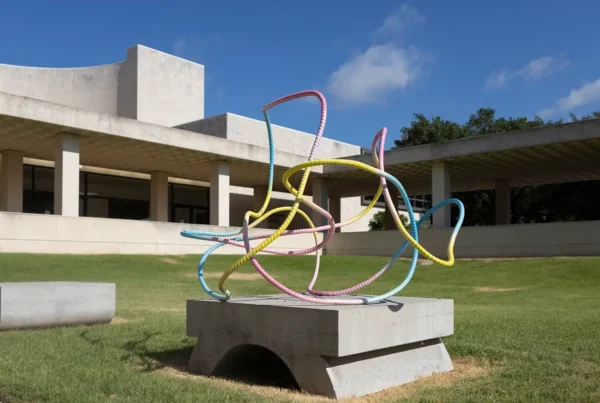“I want my work to be living objects, not dead.”
A Journey Shaped by Fantastical Environments
Yuko Nishikawa is a Japanese artist, well-known for her creation of fantastical environments characterized by an effusion of vivid, textural forms. Her artistic practice involves a hands-on, experimental methodology to generate a diverse range of works, including paintings, lighting fixtures, mobiles, and sculptures. She deftly manipulates a variety of mediums such as clay, wire, fabrics, and ingeniously incorporates repurposed materials, like recycled paper and used eyewear lenses, into her works. Nishikawa’s distinctive portfolio reflects her diverse experiences and interests, spanning architecture, restoration, interior and furniture design, crafts, and engineering.
Born and raised in a serene seaside town south of Tokyo, Japan, Nishikawa relocated to New York City in the 1990s. Currently, she resides in Brooklyn, where she also operates her personal studio.
Upon her arrival in New York, Nishikawa pursued her interest in architecture and space by studying Interior Design at the esteemed Fashion Institute of Technology. Post-graduation, she dedicated her skills to various interior design and architecture-oriented studios, before shifting her focus to designing furniture and lighting for a furniture company, a role she fulfilled for an impressive nine-year tenure.
During this period, Nishikawa began leasing a workspace in a communal ceramic studio, driven by her desire to master wheel-throwing. This marked yet another addition to her rich tapestry of skills, joining other self-initiated pursuits such as glass-blowing, welding, painting, and woodworking. Clay emerged as a favored medium for Nishikawa, its tactile nature and economical viability inviting repeated experimentation. She appreciated the profound transformation it undergoes upon firing, equating ceramic to the earth’s magma.
While still working as a furniture designer, Nishikawa constructed her own studio, envisioning it as a playground for her artistry, unencumbered by commercial pressures. This commitment to her passion culminated in a sabbatical in 2017, allowing her to fully immerse in unrestricted creative exploration in her studio. A year later, she transitioned to dedicating herself entirely to her personal studio, marking a significant milestone in her journey as an independent artist.

Yuko Nishikawa: Tracing the Origins of Creative Whimsy
The inception of Yuko Nishikawa’s passion for art and design doesn’t align with a single, vivid memory of entrancement. Instead, the artist’s journey is better defined as a gradual accretion of interests and pursuits, harking back to the days of her youth. As a child, Nishikawa was captivated by the process of painting and crafting, yet the origins of this intrigue remain elusive even to her.
Nishikawa’s childhood whimsy offers telling insights into her creative spirit. A notable anecdote involves a pair of scissors that she, once given permission, used to cut her own hair much to her mother’s astonishment. Another peculiar childhood fascination was a bag with a malfunctioning zipper that slid freely in both directions without ever truly closing. These seemingly mundane objects sparked Nishikawa’s curiosity, heralding the fascination for mechanics that would later come to influence her art.
As a young artist, she displayed an inherent predilection for collaborative creativity, demonstrated through drawings created for friends and puppet shows orchestrated for birthday parties. Nishikawa also cultivated a connection with the performing arts, playing piano for school music events and even attempting her hand at playwriting.
Nishikawa’s artistic journey began with ceramics but eventually expanded to encompass a variety of media, including paper pulp, wires, paints, fabrics, electrical components, and lenses. She perceives her oeuvre not as a collection of isolated pieces but as a cohesive, interconnected body of work. This holistic perspective emphasizes the importance of an ongoing evolution and development in her artistic practice.
Despite the distinctive elements often associated with her work, Nishikawa consciously rejects the notion of having a style, viewing it as a constraint akin to a habit. Instead, she acknowledges certain inherent characteristics, such as her handwriting, her voice, or her gait, as inevitable aspects of her identity that subtly permeate her work. These traits, as she puts it, are ‘haunting’, persistently present without a clear point of origin. Nishikawa’s oeuvre reflects this fluid interplay of the known and the unknowable, creating a fascinating narrative that compels viewers to explore and interpret.

Transforming Space and Time through Art
In her creative process, Yuko Nishikawa actively pursues ideas that resonate deeply with her personal vision, thereby fostering the capacity to transform a given space and time into a unique, immersive experience for her audience. Her aspirations extend beyond the studio and into the realm of large-scale paintings and outdoor sculptures, a dream that reflects the grandeur and magnitude of her artistic vision.
Nishikawa’s work often incorporates elements such as mushrooms, bugs, and molds – organisms that exhibit a quiet, tenacious survival instinct. These life forms, which appear to spring forth from nowhere and persist against all odds, mirror other thematic interests in her oeuvre, such as time, memory, thoughts, and anatomical elements. The image of mushrooms sprouting from the clay walls of her childhood home not only personifies the passage of time, but also indicates a shift in her perception: a detail once overlooked now richly imbued with artistic inspiration.
Natural light serves as a fundamental component of Nishikawa’s working environment, influencing her aesthetic sensibilities and contributing to her productivity. Her artistic discipline has evolved over time, guided by a conscious effort to cultivate focus amidst potential distractions. Initially, she employed methods like setting timers to compartmentalize her work process and manage peripheral thoughts. This approach effectively addressed her concerns about time management, allowing her to devote undivided attention to her artistic process.
Today, Nishikawa no longer relies on such mechanisms to regulate her workflow. Her relationship with time has undergone a transformation, evolving from a force to be grappled with to a harmonious component of her work rhythm. Her ability to concentrate on the task at hand is predicated on an implicit pact with herself: the trust that she will address secondary concerns in due course. This philosophy not only reflects her dedication and commitment to her work but also serves as a testament to her personal growth and maturity as an artist.

Yuko Nishikawa: Infusing Life and Emotion into the Inanimate
Yuko Nishikawa does not confine her inspirations to a specific individual or aesthetic. She amasses fragments of insight from the diverse phenomena and personalities that she encounters in her life’s journey. One can see parallels between her thought process and that of musicians who profoundly engage their audience’s emotions, evoking joy, melancholy, or even an urge to dance. Her aspiration is for her artistry to emulate this powerful dynamic inherent in music, where listeners participate actively, thus transforming the art into a uniquely personal experience.
Nishikawa strives to imbue her creations with an intrinsic lifeforce, one that evolves and matures in harmony with its handlers. Her objective is for her work to be thoroughly entwined with the daily experiences of those who interact with it, consequently adapting and ageing symbiotically. Once the artifact is birthed, it gains its own agency, an entity that, like all living things, is prone to change. Nishikawa’s desire is for her creations to be perceived as living objects rather than inanimate ones.
Immersed in the rich tapestry of Japanese culture, Nishikawa has internalized the belief that every object, from the humble tea cup to the stoic table, possesses a spirit. The walls, the land, even the unassuming daikon radishes, are imbued with an unseen life force. As she crafts her sculptures and lamps, she seeks to channel emotions and infuse life into the inanimate. What she observes in her art is not merely an object, but an expressive entity – possibly smiling, conversing, or expressing discontent. Such perceptions could be attributed to her Japanese upbringing, where the world is viewed not merely in physical form, but as a mirroring of facial or body gestures, pulsating with subtle emotional cues.






